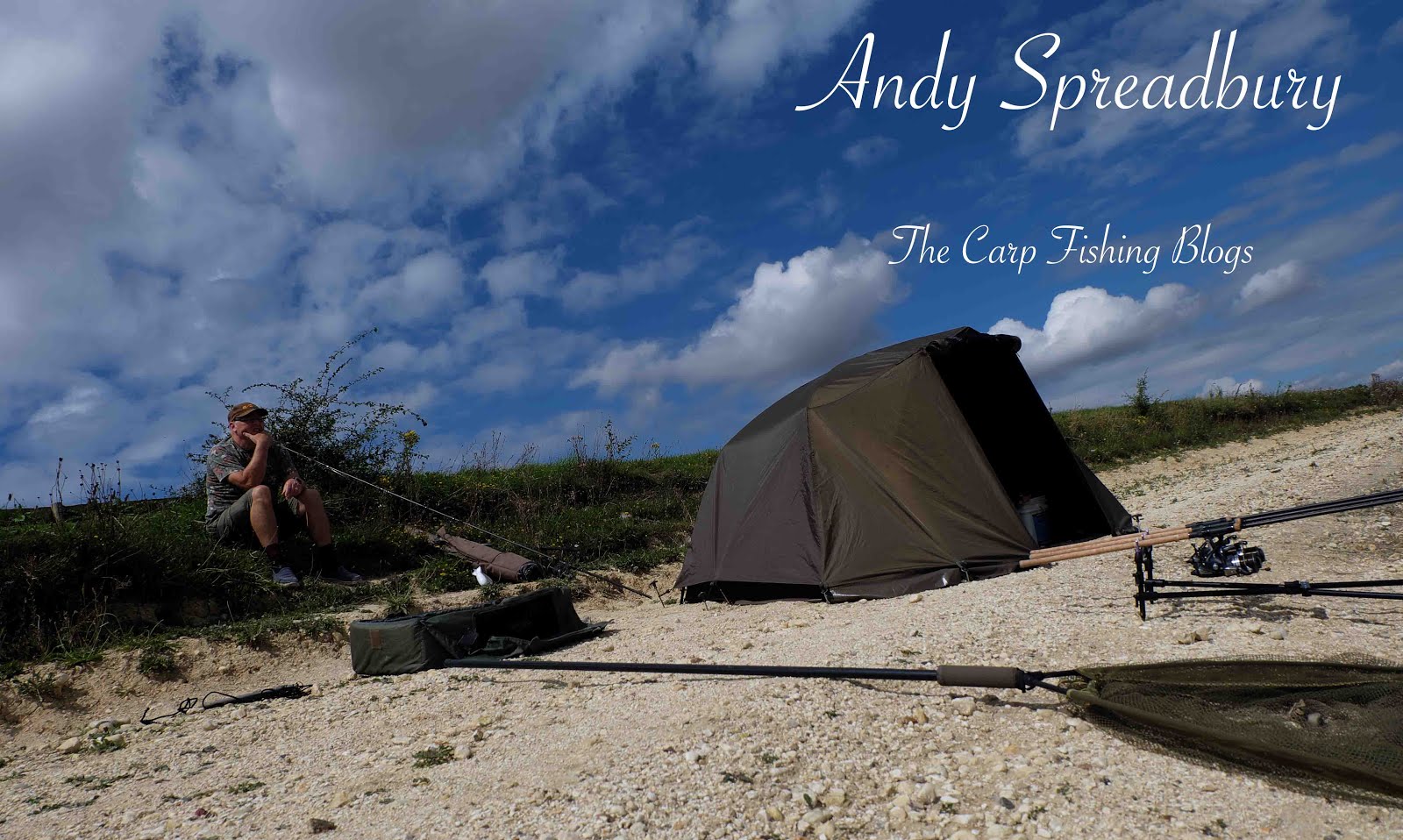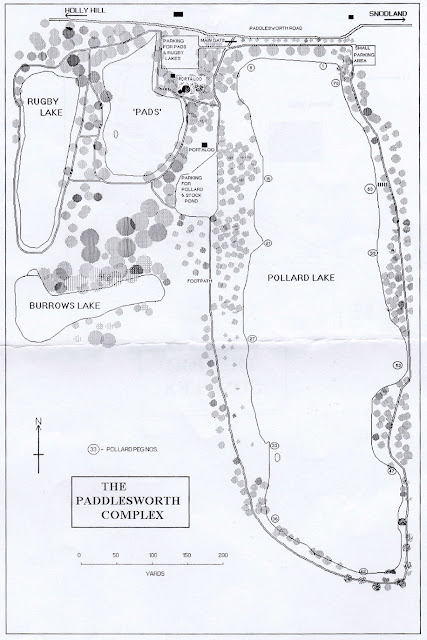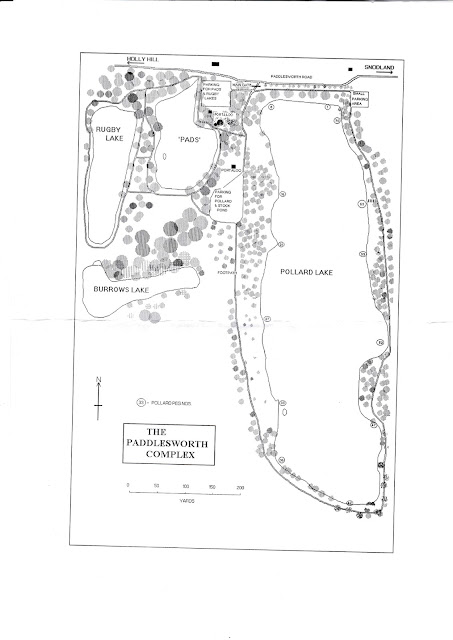Tuesday, 19th.June
Bough Beech, White House Point
11.45Survey, with a rapidly dropping water level:
Distance: 17 wraps, depth: 34 feet, temperature: 20C
Distance: 12 wraps, depth: 18 feet, temperature: 20C
Temperature in the edge: 21.4C
I got this castable thermometer on eBay but I think the problem with it is, is that it’s so fast reacting, that by the time you’ve reeled the thing in, you’re getting an ambient reading instead of what is at the bottom of however many wraps you are at.
12.30
All rods on the dancefloor, fishing single 18mm ‘Pokernut’ boilies; no snowmen, pop-ups or anything else - just the boily out of the bucket. For an explanation as to why - read my Blog ‘Moulin-de-Gassas’, Parts 1 and 2.
Spodded boilies over the top at 12 wraps, so fishing in 18 feet of water.
14.45
Fishing Bough Beech seems to be so much more about persistance and endurance than the pure implementation of angling skills.
I popped in to the Car Park Corner before coming round to the West Bank, as much to assess water levels and swim availability as anything, and never saw a fish anywhere. I haven’t seen a carp either in or out of the water since joining so really have no idea whether I might be in the right place or not. It’s not how I would prefer to fish - I always prefer to set up on fish I can see, but I feel I have no choice other than to choose somewhere on gut instinct. There might not be one within half a mile of where my baits are. I just have a hunch however that sooner or later, if I keep fishing the water often enough, a carp will come past my baits and pick one up. Is it possible to fish a whole season on any water and not have a carp come near you at some point? Theoretically, I suppose so; practically? I don’t know.
18.00
Topped up the spot with a few spods of ‘Pokernut’ and replaced the baits on all three rods.
I mentioned somewhere else that Bough Beech carp will be caught by just good, solid angling and I feel this is what I am doing right now. Simple baits on simple rigs, fished over a distribution of free baits. Plain, simple angling, with no complications or over-thinking.
19.45
Just done a quick calculation for the slope of the bottom of the reservoir and it is 1 in 8 (18 feet at 12 wraps = 48 yards = 144 feet. 144 divided by 18 = 8). For every eight feet horizontally, the depth drops one foot.
It doesn't take long for Nature to re-claim the land. Turning green already with terrestrial plants. Imagine what it would be like if we didn't build anywhere and left the land to sort itself out?
So far the water has receded 3 wraps in this swim, that’s 3 wraps = 12 yds. = 36 feet, so this means the water has lost 4.5 feet since May.
20.45
Wind from the SW and easing. Midges gyrating around at the water margins. Perhaps I am completely wrong about the areas laid bare by the receding water, being devoid of chironomid larvae and thus bare of food for the carp? Perhaps they do feed in the shallows after all?
My friend Phil says the carp do show - but I’ve yet to see or hear one. What a boost to the confidence it would be if I did?
Wednesday, 20th.June
Rig evolution. I have always constantly changed my mind about rigs, new experiences (and generally lack of success) prompting me to try something different.Although I have caught fish on the stiff, fluorocarbon rig - and I appreciate its anti-eject capability; the very thing that makes it anti-eject, namely its stiffness and thus resistance to being blown out - also makes it difficult for it to be sucked in. Newton’s Laws of Motion. For every Action, there is an equal and opposite Reaction. If it’s hard to blow out - then it’s hard to suck in.
Imagine. It’s lying stiff on the bottom, from bait to to lead with only the swivel at the lead permitting any kind of hinge-ing. How does a carp actually get it in its mouth? Only the inherent suppleness of the fluorocarbon (and there’s not a lot of that) can permit the bait to move in a vertical direction into the fish’s mouth.
Taking this line of thinking to its logical extreme, only a braided hooklength permits the greatest capability for such movement and this implies the use of a solid bag which I don’t want to use on here because the Bream will snaffle the pellets easy as you like.
What I have done is put on a combi-rig with the last half-inch as the braided section. This at least provides the theoretical vertical movement for a carp to actually pick the bait up off the bottom and allow the hook to drop into the bottom of the fish’s mouth. By moving the hinge from the lead end - to the hook end, the hook is at least able to move from the horizontal to the vertical, an essential if self-hooking is to be achieved.
The blob of putty aids the hinge-ing of the hook.
Rigs are always about Confidence. Not confidence in the sense that a carp is confident in taking the bait; confidence from an angler point of view. The angler has to be confident in what he is using. Although it may not make a blind bit of difference in a practical sense - if it bolsters the angler’s confidence then it’s worth doing because the biggest advantage an angler can ever have is Confidence.
06.40
Bough Beech looks a very dour, forbidding place this morning. It is grey, dull, misty and damp, and very uninviting. Once again I feel there is great psychological inertia to overcome on here - the sheer size and scale of the place, the low stock, and low chance of success, all mean a lack of good news on the carp front.
How long can I continue blanking on here? There is always the thought that I could be on other waters catching fish. And yet I can not give up yet.
This morning feels as if I am never going to get one; as if a take is never going to come. What is the point of being on here? There is no virtue in continued failure and today I feel I have reached the point where I am wondering whether my time on here is wasted.
Of course, it won’t be waste if I catch something because… “all it takes is one bite.”
Such are the extremely fine lines between worth and worthlessness.
07.15
I’ve some further thoughts on rigs. It’s to do with making it easier for the carp to pick the bait up in the first place, and yet to have sufficient anti-tangle properties such that it doesn’t land in a mess when you cast the thing out.
Mono. We always used to use mono; in fact back in the day it was the only thing to use. Of course, we then had braided Dacron, Multi-Strand (do you remember that - a nightmare to use!), and then braid made from Dyneema fibres and other materials. Coated braids didn’t come along until much later.
I don’t like coated braids. For one thing they are damned expensive. £14 for just 20 metres! They’re having a laugh! I can buy over 1000 yards of Daiwa Sensor mono for a tenner!
We used to use eight or ten pound ‘Sylcast’ back in the day, getting only occasional tangles. In the recent past I’ve used 15 pound Daiwa Sensor and generally don’t get any, especially now we have anti-tangle tubing and lead clips which is something we never used to have in the days of the dinosaurs.
Mono hooklinks combine just the right amount of suppleness, with stiffness to allow the bait to be picked up - but also to resist tangling.
Simple. Functional. No-nonsense. Works. Does what it says on the tin.
From a psychological point of view, they give me something I can go forward with in renewed hope and confidence. 07.40 A stuttering take on this rig has produced a Bream. Normally I would resent the presence of Bream but this does rather prove a point I feel. If it’s supple enough for a Bream to get it in its mouth, then it’s certainly supple enough for a carp. The fluorocarbon rigs laying out there right beside it have produced only one and two bleep indications; they were interested, but couldn’t get the rig in their mouths. Hmmmm…







Comments
Post a Comment